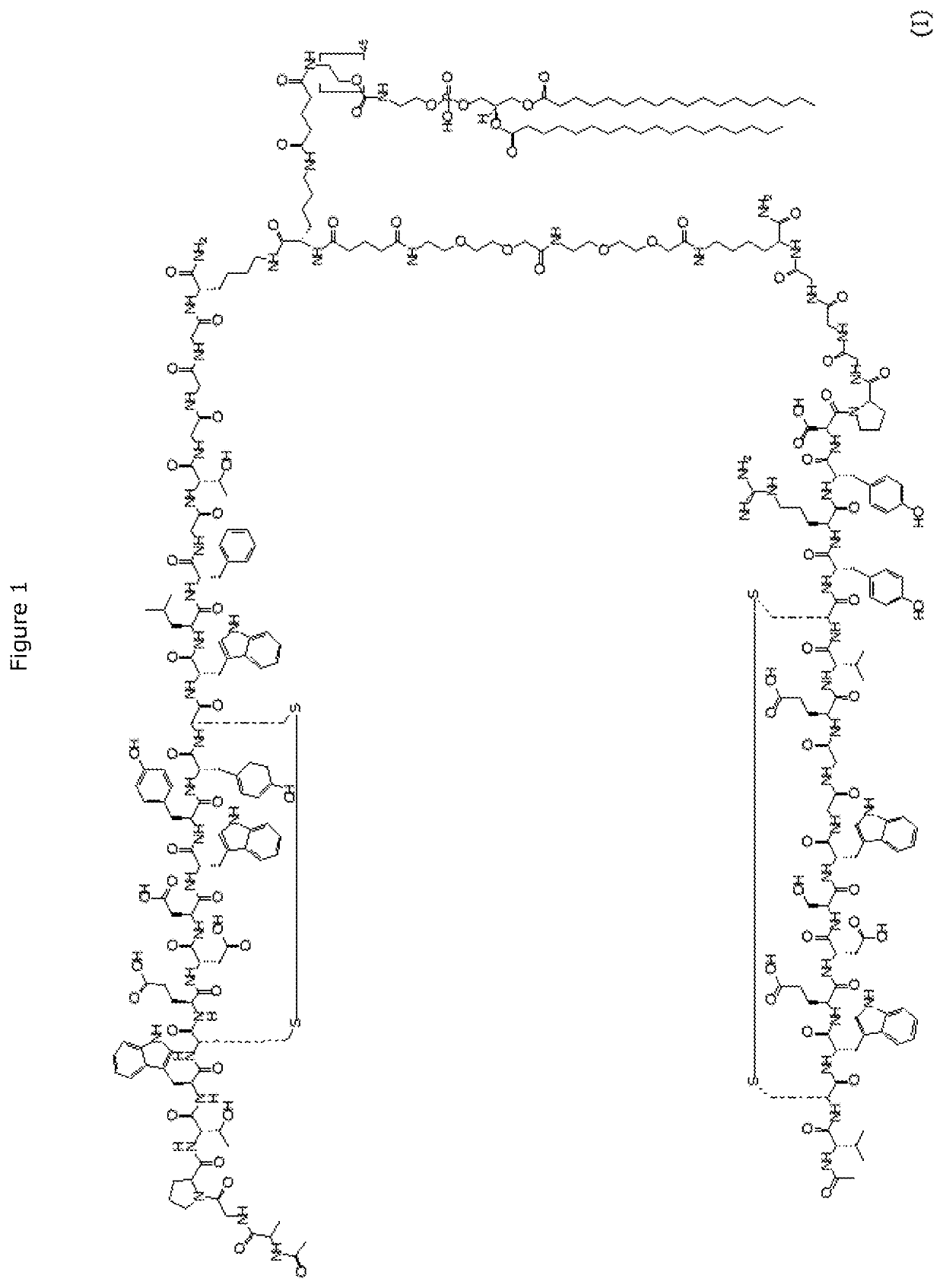Optimized process for dimeric peptide-phospholipid conjugate
a technology of phospholipid conjugate and dimeric peptide, which is applied in the field of kdrtargeting peptide-phospholipid conjugate, can solve the problems of complex purification and isolation of the final product, loss of costly heterodimer, and high content of trifluoroacetic acid (tfa)
- Summary
- Abstract
- Description
- Claims
- Application Information
AI Technical Summary
Benefits of technology
Problems solved by technology
Method used
Image
Examples
example 1
on of the Intermediate (II)
[0074]Before conjugation with the pegylated phospholipid, the heterodimer (IV) has been activated by coupling with a di(N-succinimidyl)glutarate moiety as a linking agent. A solution of heterodimer acetate (49.08 mg) in 500 μL DMF was added portionwise (7×70 μL) every 2 minutes to a disuccinimidylglutarate solution with DIEA (130 μL). To avoid dimer condensation, an excess of DSG (5 eq.) and DIEA (5 eq.) was used. After stirring at room temperature for 30 min after the last addition, the activated heterodimer was isolated and analysed by HPLC to confirm the reaction completeness. For these analyses, the following chromatographic conditions were applied:[0075]Column: Phenomenex Luna 5μ C18 (250×4.6 mm)[0076]Eluent A: 10 mM AcONH4 in H2O[0077]Eluent B: 10 mM AcONH4 in H2O / ACN (1 / 9)[0078]Flow rate: 1.5 mL / min[0079]Detector: UV 214 nm[0080]Gradient: from 25% to 52% of mobile phase A[0081]Retention time: 12.69 min
example 2
of Compound (II)
[0082]Compound (II) obtained in example 1 was isolated to remove the excess of DSG from the reaction mixture. The suspension was concentrated under reduced pressure to remove DMF. The dry crude was washed with 10 mL EtOAc and then centrifuged 3 min at 2500 g. The supernatant was decanted in a 100 mL round bottom flask while solid was washed twice with 15 mL of EtOAc and dried under reduced pressure yielding 47.02 mg of a white powder.
example 3
of Compound (I)
[0083]The synthesis of compound (I) was performed according to the step reported in Scheme 1. The reaction progress was followed using analytical reversed phase HPLC or UPLC with UV detector at 220 nm or ELSD detector.
Steps i)-iii) Conjugation and Isolation of the Product (I)
[0084]A sample of DSPE-PEG2000-NH2 ammonium salt (18 μmol, 50.23 mg, 2 eq.) was dissolved in 300 μL of anhydrous DMF and then DIEA was added (2 eq.) to reach a total volume of 315 μL.
[0085]Compound (II) was solubilised in 400 μL of DMF, then added in five portions to the mixture of DSPE-PEG2000-NH2 and DIEA and let overnight under stirring.
[0086]An aliquot was collected for analytical HPLC monitoring and the profile showed a main peak eluting at a retention time of about 12.5 min. The mixture was then concentrated under reduced pressure recovering 105.5 mg of crude product. 5 mL of water was firstly added reaching a pH of 4.8; however, to obtain a complete solubilisation and a limpid solution, abo...
PUM
| Property | Measurement | Unit |
|---|---|---|
| column temperature | aaaaa | aaaaa |
| total volume | aaaaa | aaaaa |
| total volume | aaaaa | aaaaa |
Abstract
Description
Claims
Application Information
 Login to View More
Login to View More - R&D
- Intellectual Property
- Life Sciences
- Materials
- Tech Scout
- Unparalleled Data Quality
- Higher Quality Content
- 60% Fewer Hallucinations
Browse by: Latest US Patents, China's latest patents, Technical Efficacy Thesaurus, Application Domain, Technology Topic, Popular Technical Reports.
© 2025 PatSnap. All rights reserved.Legal|Privacy policy|Modern Slavery Act Transparency Statement|Sitemap|About US| Contact US: help@patsnap.com



